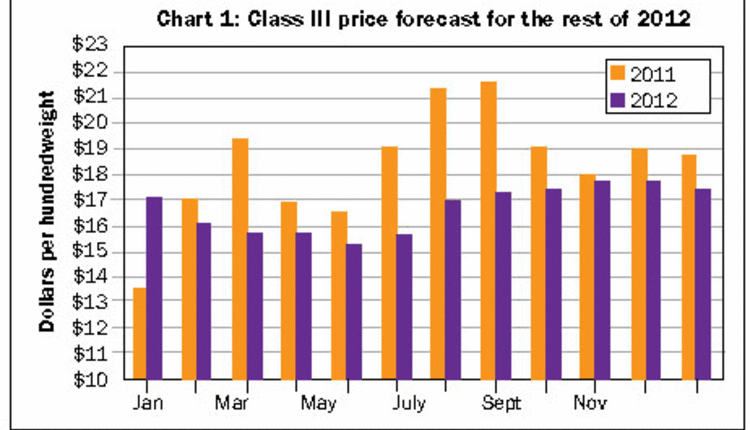The author is a professor emeritus and dairy marketing specialist at University of Wisconsin-Madison.
At the beginning of the year, forecasts indicated lower milk prices for the first half of the year but a nice recovery for the second half. So far milk prices have been lower . . . lower than many forecasted for the beginning of the year. Projections for the second half are for higher pay prices. Opinions differ as to how much prices will improve. Milk prices are so sensitive to small changes in or anticipated changes in production and/or dairy product sales including dairy exports.
The growth in milk production from January through April put downward pressure on pay prices. U.S. milk production on a daily basis was 3.9 percent higher than a year ago for the January through April period. These gains were due to more milk cows and, more importantly, a relative strong gain in milk per cow.
Milk cow numbers had grown each month since October 2010. As of April, milk cow numbers had risen 49,000 head since the end of last year resulting in 90,000 more milk cows than the same time last year. Milk per cow, which rose just 0.9 percent for all of 2011, averaged 2.9 percent higher January through April (adjusted for a daily basis). While good feed management may have been a contributing factor, favorable weather across the country this past winter and spring no doubt was a bigger contributing factor to more milk per cow.
Applied downward pressure
With this strong growth in milk output, markets could only clear at lower prices. Fluid milk sales, which utilize about 30 percent of U.S. milk production, dropped 1.2 percent in 2010, another 1.7 percent in 2011 and were 2.5 percent lower this January through April. This meant the gains in milk production needed to be absorbed by manufactured dairy products. Compared to a year ago, January through April dairy product production (daily adjusted) was up 41 percent for nonfat dry milk, 7.7 percent for butter and 3.5 percent for cheese.
Dairy exports have helped to clear some of this production. Compared to a year ago, January through April exports were up 8 percent for nonfat dry milk/skim milk powder, 12 percent for cheese, 2 percent for whey proteins and 5 percent for lactose, but down 33 percent for butter.
Milk prices set a new record last year with the Class III price averaging $18.37 and the U.S. All-Milk Price settling at $20.14. By comparison, the Class III price averaged $16.65 January through May of last year compared to $15.96 this year. That is only a 69-cent spread at this point. What does the remainder of the year hold?
The milk price outlook improved with USDA's milk production report for May. Milk cow numbers fell by 4,000 head from April and were just 0.8 percent higher than a year ago. The upward trajectory in milk per cow slowed to just 1.2 percent, giving a gain in total milk production of just 2 percent. With domestic sales and dairy exports at a 2 percent growth rate, the outlook is starting to look bullish for milk prices. As a result, cheese and butter prices rose, and dry whey and nonfat dry milk prices were firm.
The June Class III price will be near $15.65. The July Class III price could reach $17 and could peak near $17.80 in October. If this holds, the Class III price will average about $16.70 for the year compared to $18.37 last year (Chart 1).

Margins are shrinking
The start of the decline in May cow numbers can be attributed to high feed costs and lower milk prices that greatly reduced margins (returns over feed costs). As noted in Chart 2, margins had fallen to $2.50 per hundredweight of milk for May. That's down from $7.47 at the beginning of the year and $13.90 a year ago.

With much lower margins along with very favorable slaughter prices, one would expect the gains in cow numbers to stop. But perhaps dairy provisions proposed for the 2012 Farm Bill did encourage some producers to maintain or even boost milk production. If passed, that provision would give producers the option of receiving at no cost margin protection (returns over feed cost) of $4 on 80 percent of their highest annual milk production for the three years prior to implementation.
Hot weather this summer could also dampen milk flow per cow and lower milk composition, reducing the yield of dairy products per 100 pounds of milk. The outlook for milk prices this fall and into 2013 will also depend heavily on crop yields as this will affect feed prices. Nevertheless, milk prices are likely to average higher in 2013 when compared to 2012.
At the beginning of the year, forecasts indicated lower milk prices for the first half of the year but a nice recovery for the second half. So far milk prices have been lower . . . lower than many forecasted for the beginning of the year. Projections for the second half are for higher pay prices. Opinions differ as to how much prices will improve. Milk prices are so sensitive to small changes in or anticipated changes in production and/or dairy product sales including dairy exports.
The growth in milk production from January through April put downward pressure on pay prices. U.S. milk production on a daily basis was 3.9 percent higher than a year ago for the January through April period. These gains were due to more milk cows and, more importantly, a relative strong gain in milk per cow.
Milk cow numbers had grown each month since October 2010. As of April, milk cow numbers had risen 49,000 head since the end of last year resulting in 90,000 more milk cows than the same time last year. Milk per cow, which rose just 0.9 percent for all of 2011, averaged 2.9 percent higher January through April (adjusted for a daily basis). While good feed management may have been a contributing factor, favorable weather across the country this past winter and spring no doubt was a bigger contributing factor to more milk per cow.
Applied downward pressure
With this strong growth in milk output, markets could only clear at lower prices. Fluid milk sales, which utilize about 30 percent of U.S. milk production, dropped 1.2 percent in 2010, another 1.7 percent in 2011 and were 2.5 percent lower this January through April. This meant the gains in milk production needed to be absorbed by manufactured dairy products. Compared to a year ago, January through April dairy product production (daily adjusted) was up 41 percent for nonfat dry milk, 7.7 percent for butter and 3.5 percent for cheese.
Dairy exports have helped to clear some of this production. Compared to a year ago, January through April exports were up 8 percent for nonfat dry milk/skim milk powder, 12 percent for cheese, 2 percent for whey proteins and 5 percent for lactose, but down 33 percent for butter.
Milk prices set a new record last year with the Class III price averaging $18.37 and the U.S. All-Milk Price settling at $20.14. By comparison, the Class III price averaged $16.65 January through May of last year compared to $15.96 this year. That is only a 69-cent spread at this point. What does the remainder of the year hold?
The milk price outlook improved with USDA's milk production report for May. Milk cow numbers fell by 4,000 head from April and were just 0.8 percent higher than a year ago. The upward trajectory in milk per cow slowed to just 1.2 percent, giving a gain in total milk production of just 2 percent. With domestic sales and dairy exports at a 2 percent growth rate, the outlook is starting to look bullish for milk prices. As a result, cheese and butter prices rose, and dry whey and nonfat dry milk prices were firm.
The June Class III price will be near $15.65. The July Class III price could reach $17 and could peak near $17.80 in October. If this holds, the Class III price will average about $16.70 for the year compared to $18.37 last year (Chart 1).

Margins are shrinking
The start of the decline in May cow numbers can be attributed to high feed costs and lower milk prices that greatly reduced margins (returns over feed costs). As noted in Chart 2, margins had fallen to $2.50 per hundredweight of milk for May. That's down from $7.47 at the beginning of the year and $13.90 a year ago.

With much lower margins along with very favorable slaughter prices, one would expect the gains in cow numbers to stop. But perhaps dairy provisions proposed for the 2012 Farm Bill did encourage some producers to maintain or even boost milk production. If passed, that provision would give producers the option of receiving at no cost margin protection (returns over feed cost) of $4 on 80 percent of their highest annual milk production for the three years prior to implementation.
Hot weather this summer could also dampen milk flow per cow and lower milk composition, reducing the yield of dairy products per 100 pounds of milk. The outlook for milk prices this fall and into 2013 will also depend heavily on crop yields as this will affect feed prices. Nevertheless, milk prices are likely to average higher in 2013 when compared to 2012.
This article appears on page 507 of the August 10, 2012 issue of Hoard's Dairyman.








